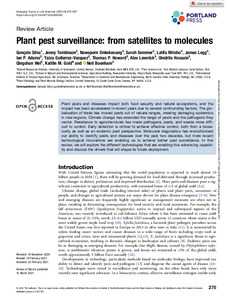| dc.contributor.author | Silva, G. |
| dc.contributor.author | Tomlinson, J. |
| dc.contributor.author | Onkokesung, N. |
| dc.contributor.author | Sommer, S. |
| dc.contributor.author | Mrisho, L. |
| dc.contributor.author | Legg, J. |
| dc.contributor.author | Adams, I.P. |
| dc.contributor.author | Gutierrez-Vazquez, Y. |
| dc.contributor.author | Howard, T.P. |
| dc.contributor.author | Laverick, A. |
| dc.contributor.author | Hossain, O. |
| dc.contributor.author | Wei, Q. |
| dc.contributor.author | Gold, K.M. |
| dc.contributor.author | Boonham, N. |
| dc.date.accessioned | 2022-02-02T15:46:51Z |
| dc.date.available | 2022-02-02T15:46:51Z |
| dc.date.issued | 2021 |
| dc.identifier.citation | Silva, G., Tomlinson, J., Onkokesung, N., Sommer, S., Mrisho, L., Legg, J., ... & Boonham, N. (2021). Plant pest surveillance: from satellites to molecules. Emerging Topics in Life Sciences, 5(2), 275-287. |
| dc.identifier.issn | 2397-8554 |
| dc.identifier.uri | https://hdl.handle.net/20.500.12478/7344 |
| dc.description.abstract | Plant pests and diseases impact both food security and natural ecosystems, and the impact has been accelerated in recent years due to several confounding factors. The globalisation of trade has moved pests out of natural ranges, creating damaging epidemics in new regions. Climate change has extended the range of pests and the pathogens they vector. Resistance to agrochemicals has made pathogens, pests, and weeds more difficult to control. Early detection is critical to achieve effective control, both from a biosecurity as well as an endemic pest perspective. Molecular diagnostics has revolutionised our ability to identify pests and diseases over the past two decades, but more recent technological innovations are enabling us to achieve better pest surveillance. In this review, we will explore the different technologies that are enabling this advancing capability and discuss the drivers that will shape its future deployment. |
| dc.description.sponsorship | Bill & Melinda Gates Foundation |
| dc.format.extent | 275-287 |
| dc.language.iso | en |
| dc.subject | Pests of Plants |
| dc.subject | Plant Diseases |
| dc.subject | Food Security |
| dc.subject | Climate Change |
| dc.subject | Remote Sensing |
| dc.title | Plant pest surveillance: from satellites to molecules |
| dc.type | Journal Article |
| cg.contributor.crp | Roots, Tubers and Bananas |
| cg.contributor.affiliation | University of Greenwich |
| cg.contributor.affiliation | Fera Science Ltd., UK |
| cg.contributor.affiliation | Newcastle University |
| cg.contributor.affiliation | International Institute of Tropical Agriculture |
| cg.contributor.affiliation | North Carolina State University |
| cg.contributor.affiliation | Cornell University |
| cg.coverage.hub | Eastern Africa Hub |
| cg.researchtheme | Plant Production and Health |
| cg.identifier.bibtexciteid | SILVA:2021 |
| cg.isijournal | ISI Journal |
| cg.authorship.types | CGIAR and advanced research institute |
| cg.iitasubject | Agronomy |
| cg.iitasubject | Climate Change |
| cg.iitasubject | Food Security |
| cg.iitasubject | Pests of Plants |
| cg.iitasubject | Plant Breeding |
| cg.iitasubject | Plant Diseases |
| cg.iitasubject | Plant Health |
| cg.iitasubject | Plant Production |
| cg.journal | Emerging Topics in Life Sciences |
| cg.notes | Open Access Article; Published online: 15 Mar 2021 |
| cg.accessibilitystatus | Open Access |
| cg.reviewstatus | Peer Review |
| cg.usagerightslicense | Creative Commons Attribution 4.0 (CC BY 0.0) |
| cg.targetaudience | Scientists |
| cg.identifier.doi | https://dx.doi.org/10.1042/etls20200300 |
| cg.iitaauthor.identifier | James Legg: 0000-0003-4140-3757 |
| cg.futureupdate.required | No |
| cg.identifier.issue | 2 |
| cg.identifier.volume | 5 |

